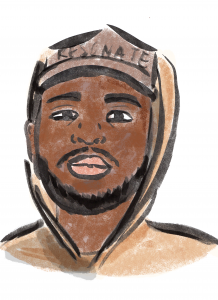As the 6 bus rolls off Lake Shore Drive into the Loop, the kid who got on at 51st and Lake Park lifts his saxophone case and prepares to exit. He hoists his backpack up to his shoulder and pulls the bulky case from under his seat. When he hefts it under his arm, a slapped on red sticker peeks out. As the teenager steps off into the swirl of workday pedestrians at Michigan and Balbo, the sticker is still visible as he moves down the block.
Its white block letters read “SAVEMONEY,” and the collective it signifies has blossomed from a group of friends into an artistic juggernaut that has taken the city—and the country—by storm.
SAVEMONEY is a Chicago rap crew, made most famous by such prominent members as Chance the Rapper and Vic Mensa. Their monikers include, to name but a few, the SAVEMONEY Family, the SAVEMONEY Army, and the Save Peso crew. Their interests range from video production to graphic design, artwork, and poetry—but music takes precedence above all, hip-hop specifically. From rhymes spat in today’s street-corner cyphers to tributes to Chicago’s jazz-blues-and-soul past, SAVEMONEY collectively produces a brand of hip-hop that, unlike some of its contemporaries in Chicago, is more than content to melt genres and to take big risks with production.
But this hip-hop collective is one that focuses as much on repping and looking out for its own as it does on racking up SoundCloud plays. When they were all kids, spitting verses after school and at poetry slams across the city, the members of SAVEMONEY were united more by friendship than music. Vic Mensa described the crew to the Weekly as starting off “as not a rap group at all. We all just used to go out and save money. Literally. On ‘five fingered discounts’ and ‘skipped’ purchases.”
For members of this nascent crew, messing around in thrift stores as kids and making music were linked, and always would be. In their interviews and lyrics, SAVEMONEY members are all about hoisting each other up. As Nico Segal said once, caught after a show, “SAVEMONEY, to me, is my friends, a group of all my friends.” In a moment from a 2012 Fake Shore Drive group interview, one that saw many of the core members gathered together, the discussion centered briefly on Chance and Kami de Chukwu. As the conversation spun, for a second, to the origins of the group, Chance leaned forward for emphasis and spoke into the camera: “We didn’t start off on some music shit.” Kami nodded approvingly and added, “It was just the natural selection.”
In short, if you insisted on stressing dichotomy to the group, insisted on tracing the group back to a shared musical epiphany, you’d be doing it all wrong. You’d be trying to pin down something intangible.
Despite how personal the group’s origins are, they’ve made their music accessible to the public. The trademark logo has popped up on bus stops, been splattered on lampposts, and gotten tucked into the corners of windows around the city. They have, at least here in Chicago, become a household name. Yet, aside from the notable faces like Chance and Vic, the ones featured in Complex and on Sway in the Morning, the minor players remain relatively unknown.
Here we’ve outlined the core musicians of SAVEMONEY, but with a special focus on the up-and-comers, those on the periphery of fame, who have been working steadily for years but are just beginning to break out.
If you asked members of SAVEMONEY what came first, friendship or music, they’d probably shake their head and laugh at how much you don’t understand, how much you can’t understand, because you’re not SAVEMONEY. (Jack Nuelle)
MAJOR PLAYERS
Chance the Rapper
@chancetherapper
Arguably the best and most celebrated Chicago rapper to break into the national scene since Kanye West himself, Chance became the object of worldwide adoration with 2013’s Acid Rap mixtape, which reached #63 on the Billboard Top R&B/Hip-Hop Albums chart, despite being released for free. With a deep and fittingly Kanye-esque appreciation for samples, often from dusty Chicago soul and jazz records, Chance channels an originality that doesn’t cater to the norms of the rest of his genre. Now based in Los Angeles, where he lives with
James Blake, Chance was the first to take SAVEMONEY national. His as-of-yet unnamed debut solo album will supposedly be released for free by the end of the year. Standout singles include “Wonderful Everyday,” his take on the theme song from children’s TV classic Arthur, and “No Better Blues,” a slow-burning, satirical list of everything he hates. (Jack Nuelle)

Vic Mensa
@VicMensa
The Hyde Park native honed his chops with local genre-benders Kids These Days before embarking on a solo career. He was catapulted into the spotlight by the solo mixtape INNANETAPE, which dropped in the summer of 2013, and this year’s much-acclaimed standout track “Down On My Luck.” While he sports a furious flow, lately Vic seems more preoccupied with exploring new styles of production and testing the waters as a suave dance floor crooner. He also snagged a gig in May of this year as the opening set at the UofC’s Summer Breeze concert. (Jack Nuelle)
BREAKOUT STARS

Nico Segal
@DonnieTrumpet
True to his nom de guerre Donnie Trumpet, Segal provided much of the brass power behind both Vic Mensa’s Kids These Days and many other projects in which SAVEMONEY has been involved. Under the Donnie moniker, Segal released a self-titled EP last year that sees contributions from other SAVEMONEY ensemble players, including multi-instrumentalists and producers Peter Cottontale (also a SAVEMONEY loyalist) and Thaddeus Tukes. After a raucous farewell show in Chicago last January, Segal moved to Los Angeles, where he makes up part of Chance’s Social Experiment and is working on dropping his own album. He and Chance recently collaborated for the phenomenal feel-good single “Sunday Candy.” (Jack Nuelle)
Caleb James
@calebjamesFBSM
James has been rapping since his early teens but has been around music his whole life. The son of former Chicago musician and current Evanston pastor Steve Huff, James hung around his dad’s studio as a boy, and, according to a recent profile in the Reader, even had a cameo on the 2003 track “Flickin’ ” by R&B artist Avante. His affiliation with SAVEMONEY began several years later, when he began work on his 2013 debut mixtape The Jones. The album features a solid mix of throwback beats inspired by nineties R&B, with James switching between exuberant raps and crooned interludes. SAVEMONEY receives copious verbal shout-outs throughout, and longtime collaborative producers and SAVEMONEY associates ThemPeople had a hand in most of the mixtape’s production. James’s follow-up mixtape, The Jones 2.0, was released this past summer. His latest track is a remix of “Pathetic” featuring Swedish producer Erik Hassle. (Jack Nuelle)
Dally Auston
@DallyAuston
One of the only members of SAVEMONEY hailing from the West Side, Auston broke onto the Chicago hip-hop scene in 2012 with his first single “Bliss,” which clocks in at a mere two minutes and sees him rapping solo over soft strings and a tinkling beat. Auston carried this subdued production into his debut EP, The Wood, which dropped in March of 2013. Auston also maintains a singular visual aesthetic in his videos and performance. The video for “99Cent,” the single off his 2014 EP Westside, features trademark visuals, including a neo-Disney slew of hand-drawn additions to the live action footage. Auston has a surreal flow in the tradition of Chance, but is less high-fire and more slow-burning. Westside showcases this best: in a flurry of languid, sparsely produced tracks, Auston drones and rambles about sex, drugs, his city, and everything in between. (Jack Nuelle)
UP-AND-COMERS

Leather Corduroys
@leatherchords
Both members of the duo Leather Corduroys, Joey Purp and Kami de Chukwu, were part of the original group of friends at Whitney Young High School that would eventually coalesce into SAVEMONEY. As Kami remembers it, “The group formed freshman year of high school. You just kind of meet and click up with people. Eventually we put a name to our situation, and it evolved into a platform that we could use to do whatever we felt like doing, which included a lot of art-based things. I think Vic was the first one to start making music as any type of professional.”
Kami also says that he didn’t try rapping until he was around seventeen, when he went to the studio a couple of times, and that he only began to take it seriously after he recorded a song called “Scrapemoney” with Preston San. The song eventually appeared on his debut mixtape, Light—and Kami found out that “a lot of people fucked with it.”
While Kami and Joey had always known they had similar influences, the duo really clicked after the two budding rappers recorded a track—“a practical joke”—called “Illuminati Slumber Party.” Ad-libbing at the end of that song, one of them hit upon the phrase “leather chords,” which eventually became the group’s official name (ambiguously, though: on Twitter the name seems to waver between Chords/Corduroys).
As Kami explains it: “We thought it was a really punk perspective, the imagery of someone on stage in leather corduroys. Why not take that shit and make it into a group?” In April of this year, the act released a six-song mixtape titled Porno Music Volume II. One highlight is “Nightmare on Chicago Ave,” where, over a sinister, bleak beat, the two skip adeptly over a couple of verses, referencing everything from Harry Potter to Christopher Wallace. (Christian Belanger)

Brian Fresco
@BrianFresco
“Don’t put me in a box,” demands Brian Fresco. The SAVEMONEY crewmember’s trap music is what defines the rapper’s presence online and throughout the city, especially his party-oriented hits like “I Meant It” and “On My Soul,” expert companions to any sort of turning-up.
However, Fresco is right to claim he is far more than that; his songs “She’s the Type” off his mixtape Mafioso and his newest song and music video “Bae” prove that his slow, easy flow has versatility beyond trap, extending to more soul-influenced sounds. Fresco claims this variety of styles is the product of him being real; the different styles reflect how he feels in a current moment.
“Real life, never fraudulent,” says Fresco of SAVEMONEY’s essence. “It’s our own personal experiences. I feel that’s what makes our music so good. It is all organic and real.”
“The strongest piece,” he adds, “is that there is not a strongest piece. Everyone is still growing and maturing.” However, he doesn’t hold back about admitting that the collective is making serious moves. “We are taking over shit. We are like Voltron. There are too many pieces that are so strong. Not one is better than the others or leads the other. We are all friends in the process. It is not a gimmick.”
Fresco says there is only one common thread: having fun. “I make you listen,” he says. “I make you vibe. Then I turn you up.” (Jola Idowu)
Sterling Hayes
@SterlingHayes
A first glance at Sterling Hayes’s SoundCloud profile shows that he has a talented group of friends—Brian Fresco, Taylor Bennett, Joey Purp, Via Rosa. For Hayes, collaborating with other artists is not just another way to work or write; it is the way in which his own music thrives. He uses the SAVEMONEY collective as a rich support system, both playing his part on the team and taking advantage of the opportunity to learn from and create with his fellow players.
While his collaborations are often contingent upon his loyalty to the SAVEMONEY alliance, Hayes’s own style is what really commands attention. His work is as poised and confident as it is raw and relentless, constantly drawing upon Hayes’s own sensitivities and personal experiences for insight. On one track off his debut EP BIGShorty, “Father’s Son,” which features Joey Purp, Hayes catalogues the personal tragedies he, his family, and his friends have faced, while also addressing violence, criminality, and excess.
Hayes explores these themes with a harsh tone appropriate for his subject, but he separates himself time and time again by maintaining control of raw aggression and turning it into a well-channeled power. He identifies closely with the individual ailments of his life and uses his lyrics to cleverly envision himself subscribing to the same criminality and violence he denounces. Awareness of Hayes’s personal conditions and those of society is a common theme in the music. His unsparing attitude toward these conditions, however, carries with it an enduring hope for change. (Emiliano Burr di Mauro)
